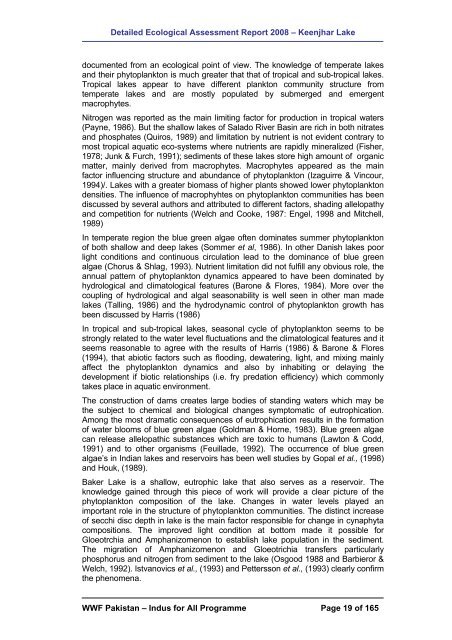Untitled - WWF - Pakistan
Untitled - WWF - Pakistan
Untitled - WWF - Pakistan
You also want an ePaper? Increase the reach of your titles
YUMPU automatically turns print PDFs into web optimized ePapers that Google loves.
Detailed Ecological Assessment Report 2008 – Keenjhar Lake<br />
documented from an ecological point of view. The knowledge of temperate lakes<br />
and their phytoplankton is much greater that that of tropical and sub-tropical lakes.<br />
Tropical lakes appear to have different plankton community structure from<br />
temperate lakes and are mostly populated by submerged and emergent<br />
macrophytes.<br />
Nitrogen was reported as the main limiting factor for production in tropical waters<br />
(Payne, 1986). But the shallow lakes of Salado River Basin are rich in both nitrates<br />
and phosphates (Quiros, 1989) and limitation by nutrient is not evident contrary to<br />
most tropical aquatic eco-systems where nutrients are rapidly mineralized (Fisher,<br />
1978; Junk & Furch, 1991); sediments of these lakes store high amount of organic<br />
matter, mainly derived from macrophytes. Macrophytes appeared as the main<br />
factor influencing structure and abundance of phytoplankton (Izaguirre & Vincour,<br />
1994)/. Lakes with a greater biomass of higher plants showed lower phytoplankton<br />
densities. The influence of macrophyhtes on phytoplankton communities has been<br />
discussed by several authors and attributed to different factors, shading allelopathy<br />
and competition for nutrients (Welch and Cooke, 1987: Engel, 1998 and Mitchell,<br />
1989)<br />
In temperate region the blue green algae often dominates summer phytoplankton<br />
of both shallow and deep lakes (Sommer et al, 1986). In other Danish lakes poor<br />
light conditions and continuous circulation lead to the dominance of blue green<br />
algae (Chorus & Shlag, 1993). Nutrient limitation did not fulfill any obvious role, the<br />
annual pattern of phytoplankton dynamics appeared to have been dominated by<br />
hydrological and climatological features (Barone & Flores, 1984). More over the<br />
coupling of hydrological and algal seasonability is well seen in other man made<br />
lakes (Talling, 1986) and the hydrodynamic control of phytoplankton growth has<br />
been discussed by Harris (1986)<br />
In tropical and sub-tropical lakes, seasonal cycle of phytoplankton seems to be<br />
strongly related to the water level fluctuations and the climatological features and it<br />
seems reasonable to agree with the results of Harris (1986) & Barone & Flores<br />
(1994), that abiotic factors such as flooding, dewatering, light, and mixing mainly<br />
affect the phytoplankton dynamics and also by inhabiting or delaying the<br />
development if biotic relationships (i.e. fry predation efficiency) which commonly<br />
takes place in aquatic environment.<br />
The construction of dams creates large bodies of standing waters which may be<br />
the subject to chemical and biological changes symptomatic of eutrophication.<br />
Among the most dramatic consequences of eutrophication results in the formation<br />
of water blooms of blue green algae (Goldman & Horne, 1983). Blue green algae<br />
can release allelopathic substances which are toxic to humans (Lawton & Codd,<br />
1991) and to other organisms (Feuillade, 1992). The occurrence of blue green<br />
algae’s in Indian lakes and reservoirs has been well studies by Gopal et al., (1998)<br />
and Houk, (1989).<br />
Baker Lake is a shallow, eutrophic lake that also serves as a reservoir. The<br />
knowledge gained through this piece of work will provide a clear picture of the<br />
phytoplankton composition of the lake. Changes in water levels played an<br />
important role in the structure of phytoplankton communities. The distinct increase<br />
of secchi disc depth in lake is the main factor responsible for change in cynaphyta<br />
compositions. The improved light condition at bottom made it possible for<br />
Gloeotrchia and Amphanizomenon to establish lake population in the sediment.<br />
The migration of Amphanizomenon and Gloeotrichia transfers particularly<br />
phosphorus and nitrogen from sediment to the lake (Osgood 1988 and Barbieror &<br />
Welch, 1992). Istvanovics et al., (1993) and Pettersson et al., (1993) clearly confirm<br />
the phenomena.<br />
<strong>WWF</strong> <strong>Pakistan</strong> – Indus for All Programme Page 19 of 165
















